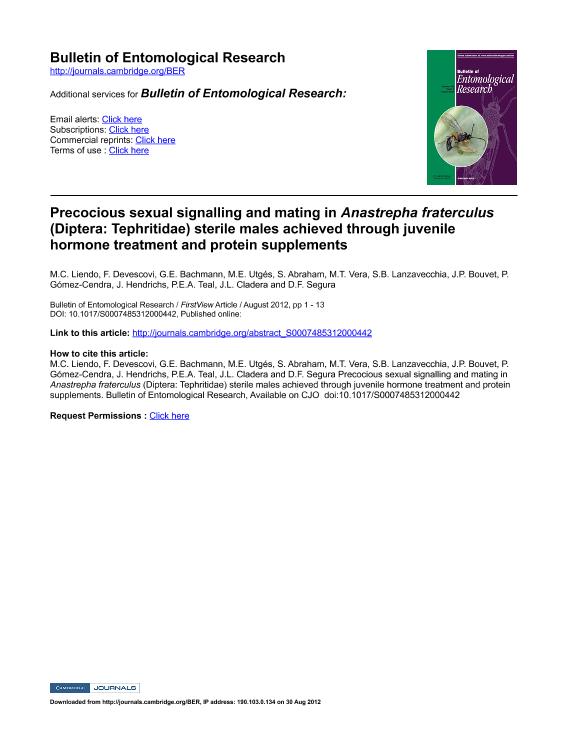Artículo
Precocious sexual signalling and mating in Anastrepha fraterculus (Diptera: Tephritidae) sterile males achieved through juvenile hormone treatment and protein supplements
Liendo, María Clara ; Devescovi, Francisco
; Devescovi, Francisco ; Bachmann, Guillermo Enrique
; Bachmann, Guillermo Enrique ; Utgés, María Eugenia
; Utgés, María Eugenia ; Abraham, Solana
; Abraham, Solana ; Vera, María Teresa
; Vera, María Teresa ; Lanzavecchia, Silvia Beatriz
; Lanzavecchia, Silvia Beatriz ; Bouvet, Juan Pedro Raúl; Gómez Cendra, Paula Valeria
; Bouvet, Juan Pedro Raúl; Gómez Cendra, Paula Valeria ; Hendrichs, J.; Teal, P. E. A.; Cladera, Jorge Luis; Segura, Diego Fernando
; Hendrichs, J.; Teal, P. E. A.; Cladera, Jorge Luis; Segura, Diego Fernando
 ; Devescovi, Francisco
; Devescovi, Francisco ; Bachmann, Guillermo Enrique
; Bachmann, Guillermo Enrique ; Utgés, María Eugenia
; Utgés, María Eugenia ; Abraham, Solana
; Abraham, Solana ; Vera, María Teresa
; Vera, María Teresa ; Lanzavecchia, Silvia Beatriz
; Lanzavecchia, Silvia Beatriz ; Bouvet, Juan Pedro Raúl; Gómez Cendra, Paula Valeria
; Bouvet, Juan Pedro Raúl; Gómez Cendra, Paula Valeria ; Hendrichs, J.; Teal, P. E. A.; Cladera, Jorge Luis; Segura, Diego Fernando
; Hendrichs, J.; Teal, P. E. A.; Cladera, Jorge Luis; Segura, Diego Fernando
Fecha de publicación:
02/2013
Editorial:
Cambridge University Press
Revista:
Bulletin of Entomological Research
ISSN:
0007-4853
Idioma:
Inglés
Tipo de recurso:
Artículo publicado
Clasificación temática:
Resumen
Sexual maturation of Anastrepha fraterculus is a long process, which creates an additional cost to the management of this fruit pest through the sterile insect technique (SIT). Methoprene (a mimic of juvenile hormone) considerably reduces the time for sexual maturation in males. However, in other Anastrepha species, this effect depends on protein intake at the adult stage. Here, we evaluated the mating competitiveness of sterile laboratory males and females that were treated with methoprene (either at pupal or adult stage) and were kept under different regimes of adult food, which varied in the protein source and the sugar:protein ratio. Experiments were carried out under semi-natural conditions, where laboratory flies competed for mating with wild sexually mature flies. Sterile, methoprene treated males that reached sexual maturity earlier (6 days-old), displayed the same lekking behaviour, attractiveness to females and mating competitiveness as mature wild males. Yet, this effect depended on protein intake. Diets containing sugar and hydrolyzed yeast allowed sterile males to compete with wild males(even at a low concentration of protein) while brewer´s yeast failed to do so even at a higher concentration. Sugar only fed males were unable to achieve significant numbers of matings. Methoprene did not increased readiness to mate on 6-days-old sterile females. These findings suggest that methoprene treatment will increase SIT effectiveness against A. fraterculus only if it is coupled with a diet fortified with protein. Additionally, methoprene acts as a physiological sexing method, allowing the release of mature males and immature females and hence increasing SIT efficiency.
Archivos asociados
Licencia
Identificadores
Colecciones
Articulos(CCT - NOA SUR)
Articulos de CTRO.CIENTIFICO TECNOL.CONICET - NOA SUR
Articulos de CTRO.CIENTIFICO TECNOL.CONICET - NOA SUR
Articulos(IEGEBA)
Articulos de INSTITUTO DE ECOLOGIA, GENETICA Y EVOLUCION DE BS. AS
Articulos de INSTITUTO DE ECOLOGIA, GENETICA Y EVOLUCION DE BS. AS
Articulos(SEDE CENTRAL)
Articulos de SEDE CENTRAL
Articulos de SEDE CENTRAL
Citación
Liendo, María Clara; Devescovi, Francisco; Bachmann, Guillermo Enrique; Utgés, María Eugenia; Abraham, Solana; et al.; Precocious sexual signalling and mating in Anastrepha fraterculus (Diptera: Tephritidae) sterile males achieved through juvenile hormone treatment and protein supplements; Cambridge University Press; Bulletin of Entomological Research; 103; 1; 2-2013; 1-13
Compartir
Altmétricas



